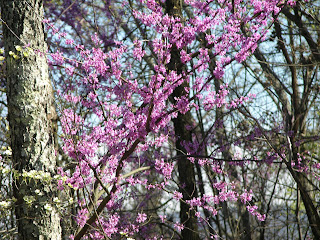Spring in Tennessee



 - Beautiful sunrise on the mountain this morning...clear and seasonably cool....followed by a high in the 70s.
- Beautiful sunrise on the mountain this morning...clear and seasonably cool....followed by a high in the 70s. - Very long hike through the woodlands yesterday...and the beauty and fresh breezes of spring are inspiring.
- Many species of woodland plants, trees and shrubs are blooming in southeast Tennessee currently....
- Attached is a photo of the Wood Anemone (Genus Anemone)....this small, single stalked woodland flower lives a solitary and inconspicuous existence, until someone notices it's brilliant white springtime flower protruding above the dead leaves of winter.
- Attached is a photo of the Wood Anemone (Genus Anemone)....this small, single stalked woodland flower lives a solitary and inconspicuous existence, until someone notices it's brilliant white springtime flower protruding above the dead leaves of winter.
- Also attached is the Eastern Redbud (Cercis), which is blooming all over Tennessee currently.
- Though the photo is a bit fuzzy, I could not help but include the attached photo of a Song Sparrow (Melospiza) in the journal. I watched this small bird hop around for a time, and at irregular intervals, it would perch atop the woodpile and sing its heart out....only to return to the grassy slopes to continue its search for a snack. It is shown here in full cry with Lake George in the background.
- Also shown is the Robin, which is more common than ever in many parts of Tennessee. Never one to frequent a bird feeder, the Robin, like this one shown hopping about in the grass near Lake George, is seemingly always in pursuit of a terrestrial meal...like an earthworm or an insect, to satisfy nutritional needs.
- I also saw many Red-Winged Blackbirds in the willows around the lake, as well as Purple Grackles, the Eastern Kingbird, European Starlings, and an interesting mix of swallows. After many photographs and a bit of research all the birds in question were either Tree Swallows or Barn Swallows. I triple checked the Tree Swallows, as some of my ID books say they are not found in southeast Tennessee. But alas, there was no doubt! I took several photos of the two species perched together on limbs of fallen trees near the edge of the lake. They seemed to have a comfortable tolerance of each other.
-Finding the identity of the birds is a relaxing and sometimes challenging activity. I still recall seeing a Merlin years ago....at first I had my doubts, and then more doubts...and only when this small falcon was viewed from a variety of angles, mostly in flight, did I know for sure what I had seen. The close cousin of the Merlin, the American Kestrel, is common here, but I still have yet to see another Merlin. Priceless.
- Though no photograph was possible, I observed a Cooper's Hawk at quite close quarters when on the hike yesterday. This impressive mid-sized predator, larger than the Kestrel, but smaller than the Buteos, has three horizontal dark bands on the tail when viewed from the dorsal side (in flight). It is larger that the very similar Sharp-Shinned Hawk, with which it is often confused.

0 Comments:
Post a Comment
<< Home